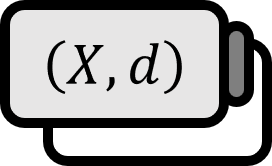거리공간에서 연속함수일 동치 조건
Theorem 1
For two metric spaces $(X,d_{X})$, $(Y,d_{Y})$, let $E\subset X$ and $p \in E$, $f : E \to Y$. Then, the following three statements are equivalent.
(1a) $f$ is continuous at $p$.
(1b) $ \lim \limits_{x \to p} f(x)=f(p)$.
(1c) For $\lim \limits_{n\to\infty} p_{n}=p$, $\left\{ p_{n} \right\}$, it follows that $\lim \limits_{n\to\infty} f(p_{n})=f(p)$.
Proof
(1a) $\iff$ (1b)
By the definition of a limit and continuity, it is trivial.
■
■
Theorem 2
For two metric spaces $(X,d_{X})$, $(Y,d_{Y})$, let $f : X \to Y$. Then the following three statements are equivalent.
(2a) $f$ is continuous on $X$.
(2b) For every open set $Y$ $O_{Y}$, $f^{-1}(O_{Y})$ is an open set in $X$.
(2c) For every closed set $Y$ $C_{Y}$, $f^{-1}(C_{X})$ is a closed set in $X$.
Here, $f^{-1}$ denotes the preimage rather than the inverse function.
Proof
(2a) $\implies$ (2b)
Assume $f$ is continuous on $X$. Let $O_{Y}$ be an open set in $Y$. By the definition of an open set, it suffices to show that every point in $f^{-1}(O_{Y})$ is an interior point of $f^{-1}(O_{Y})$. Consider an arbitrary $f(p) \in O_{Y}$. Then $p \in f^{-1}(O_{Y})$ holds. Since $O_{Y}$ is open, $f(p)$ is an interior point of $O_{Y}$. Thus,
$$ \begin{equation} d_{Y}(y,f(p)) < \varepsilon \implies y \in O_{Y} \label{eq1} \end{equation} $$
holds for some positive $\varepsilon$. Then, since $f$ is continuous on $X$, for this $\varepsilon$, there exists
$$ \begin{equation} d_{X}(x,p) < \delta \implies d_{Y}(f(x),f(p))<\varepsilon \label{eq2} \end{equation} $$
some $\delta >0$ such that it holds. However, by $\eqref{eq1}$, $\eqref{eq2}$,
$$ d_{X}(x,p) < \delta \implies d_{Y}(f(x),f(p))<\varepsilon \implies f(x)\in O_{Y} $$
holds, and hence $x \in f^{-1}(O_{Y})$. Therefore, for some positive $\delta$,
$$ d_{X}(x,p) < \delta \implies x \in f^{-1}(O_{Y}) $$
holds, so $p$ is an interior point of $f^{-1}(O_{Y})$ and $f^{-1}(O_{Y})$ is open.
■
(2b) $\implies$ (2a)
Assume (2b). Choose arbitrary $p \in X$ and $\varepsilon >0$. Let the set $O_{Y}$ be defined as follows.
$$ O_{Y} =\left\{ y : d_{Y}(y,f(p))<\varepsilon \right\} $$
Then, $O_{Y}$ is an open set in $Y$. Hence, by assumption, $f^{-1}(O_{Y})$ is open in $X$. Therefore,
$$ d_{X}(x,p) <\delta \implies x \in f^{-1}(O_{Y}) $$
there exists a positive $\delta >0$ such that this holds. Then,
$$ x\in f^{-1}(O_{Y}) \quad \text{and} \quad d_{X}(x,p)< \delta \implies d_{Y}(f(x),f(p))<\varepsilon $$
holds, so by the definition of continuity, $f$ is continuous at every $p \in X$.
■
(2b) $\iff$ (2c)
By showing (2b) $\implies$ (2c), the opposite direction can be demonstrated with similar logic, hence the remaining proof is omitted. Assume (2b) holds. Unpacking for the open set $Y$ $O_{Y}$ yields the following.
$$ O_{Y}\mathrm{\ is\ open\ in\ } Y \implies f^{-1}(O_{Y})\mathrm{\ is\ open\ in\ }X $$
As the complement of an open set is a closed set, let $O_{Y}=(C_{Y})^{c}$, then the statement becomes:
$$ C_{Y}\mathrm{\ is\ closed\ in\ } Y \implies f^{-1}((C_{Y})^{c})\mathrm{\ is\ open\ in\ }X $$
However, since $f^{-1}((C_{Y})^{c})=(f^{-1}(C_{Y}))^{c}$, the following holds:
$$ C_{Y}\mathrm{\ is\ closed\ in\ } Y \implies (f^{-1}(C_{Y}))^{c}\mathrm{\ is\ open\ in\ }X $$
Additionally, since the complement of an open set is closed, the following holds:
$$ C_{Y}\mathrm{\ is\ closed\ in\ } Y \implies f^{-1}(C_{Y})\mathrm{\ is\ closed\ in\ }X $$
■
